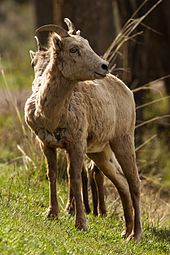Stupid Question Regarding Bighorn Sheep.
Does BC have both Rocky Mountain Bighorn AND Sierra Nevada (California) Bighorn Sheep?
Common knowledge would suggest that BC has both (although I have seen neither in the wild), however Wikipedia (generally a good source imho) seems to suggest that scientists have a new view on genetics and that BC has only Rocky Mountain sheep and no Sierra Nevada Sheep (fka California) Big Horn.
https://en.wikipedia.org/wiki/Bighorn_sheep
In the event that we have both species in our beautiful province, does anyone know which species you would find across the major regions (3, 4, 5, [7-19] and?
Sorry for asking a yes/no question, but the internet seems to be full of contradictory information on the subject.
Former[edit]
In 1940, Ian McTaggart-Cowan split the species into seven subspecies, with the first three being mountain bighorns and the last four being desert bighorns:[10]
- Rocky Mountain bighorn sheep, O. c. canadensis, found from British Columbia to Arizona.
- Badlands bighorn sheep or Audubon's bighorn sheep, O. c. auduboni, occurred in North Dakota, South Dakota, Montana, Wyoming, and Nebraska. This subspecies has been extinct since 1925.
- California bighorn sheep, O. c. californiana, found from British Columbia south to California and east to North Dakota. The definition of this subspecies has been updated (see below).
- Nelson's bighorn sheep, O. c. nelsoni, the most common desert bighorn sheep, ranges from California through Arizona.
- Mexican bighorn sheep, O. c. mexicana, ranges from Arizona and New Mexico south to Sonora and Chihuahua.
- Peninsular bighorn sheep O. c. cremnobates, occur in the Peninsular Ranges of California and Baja California
- Weems' bighorn sheep, O. c. weemsi, found in southern Baja California.
Current[edit]
Starting in 1993, Ramey and colleagues,[11][14] using DNA testing, have shown this division into seven subspecies is largely illusory. Most scientists currently recognize three subspecies of bighorn.[15][16] This taxonomy is supported by the most extensive genetics (microsatellite and mitochondrial DNA) study to date (2016) which found high divergence between Rocky Mountain and Sierra Nevada bighorn sheep, and that these two subspecies both diverged from desert bighorn prior to or during the Illinoian glaciation (about 315–94 thousand years ago).[17] Thus, the three subspecies of O. canadensis are:
- Rocky Mountain bighorn sheep (O. c. canadensis) – occupying the U.S. and Canadian Rocky Mountains, and the Northwestern United States.
- Sierra Nevada bighorn sheep (O. c. sierrae) – formerly California bighorn sheep,[16] a genetically distinct subspecies that only occurs in the Sierra Nevada in California. However, historic observer records suggest that bighorn sheep may have ranged as far west as the California Coastal Ranges which are contiguous to the Sierra Nevada via the Transverse Ranges. An account of "wild sheep" in the vicinity of the Mission San Antonio near Jolon, California and the mountains around San Francisco Bay dates to circa 1769.[18]
- Desert bighorn sheep (O. c. nelsoni) – occurring throughout the desert regions of the Southwestern United States and Northwestern Mexico. The 2016 genetics study suggested more modest divergence of this desert bighorn sheep into three lineages consistent with the earlier work of Cowan: Nelson's (O. c. nelsoni), Mexican (O. c. mexicana), and Peninsular (O. c. cremnobates). These three lineages occupy desert biomes that vary significantly in climate, suggesting exposure to different selection regimens.[17]




 Reply With Quote
Reply With Quote